This is part 3 of a 3-part Z Cam E2-M4 review: part 1 covers the hardware, part 2 covers controls and operation.
Performance
Resolution
In 4K, the camera sees all the way to 2160 TV lines/picture height and beyond: I doubt there’s any anti-aliasing filter on the sensor.
Here’s a pixel-for-pixel extract from a 4K shot of a 4K DSC Labs MegaTrumpet test chart (the inset is the full image, for reference):
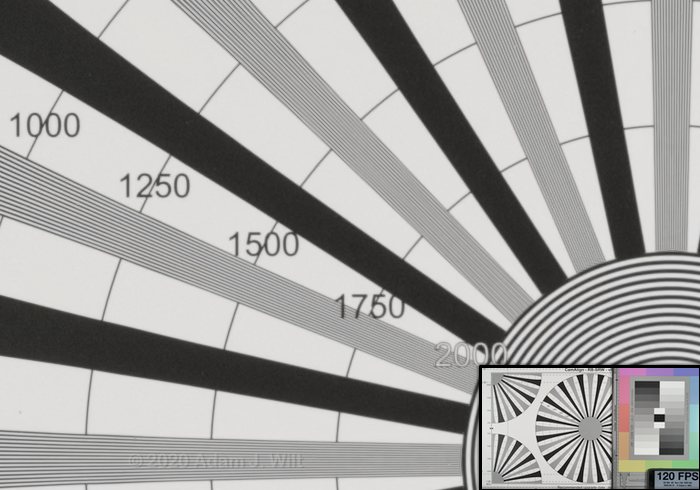
On a “properly” filtered Bayer-pattern sensor we should expect to see up to 80% of the nominal resolution, or around 1730 TVl/ph. But the E2-M4 sees distinct detail all the way to the 2000 TVl/ph limit of the chart. So I zoomed out 2x; the chart is half-size in the image so it effectively becomes an “8K” test chart:
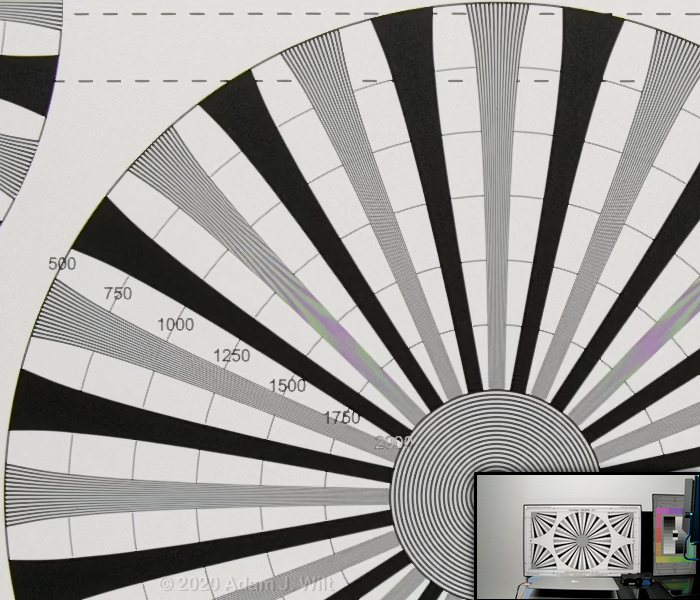
Sure enough, nothing squashes those fine lines; they just alias like crazy, all the way out to 4000 TVl/ph.
Practically speaking, this means that the E2-M4 delivers a highly-detailed image, but there is a chance of visible moiré on dense, high-contrast textures such as woven fabrics. Practically speaking, I haven’t seen it much; I can arrange shots where it’s there if I’m looking for it, but it doesn’t leap out of its own accord. It’s something to be aware of, but not to be afraid of (and if it really bothers you, just stop down to f/11 and it goes away, as the diffraction serves as a low-pass filter).
All other pixel-for-pixel formats in the camera behave the same way.
1920×1080 is derived from the full-frame 4K image, up to 120 fps. It looks like this:
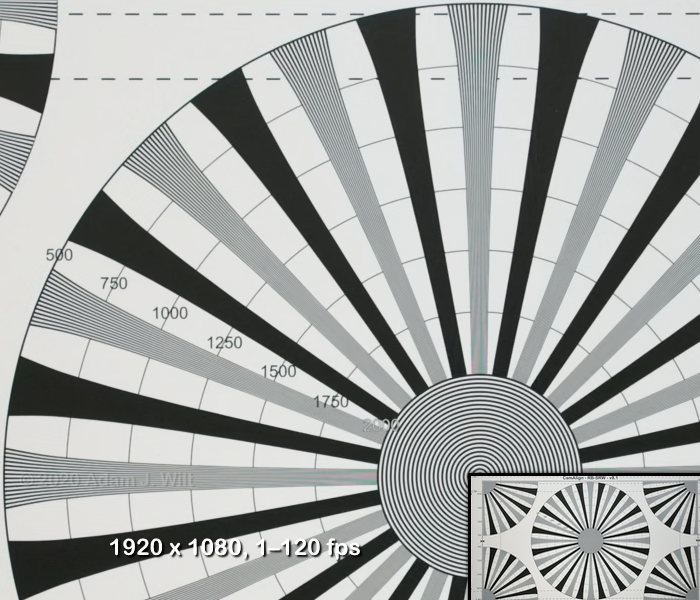
Dynamic Range
The camera is said to capture 13 stops of dynamic range, and I measured that in both Z-Log2 and Flat, and also in HLG, using a DSC Labs Xyla-21 DR test chart. Rec.709 on the E2-M4 is low-contrast enough that 12 or 13 stops are available. Concert eked out about 11 stops.
I had high hopes for WDR, as in theory it should yield up to 16 stops. However I wasn’t able to see anything more in WDR than in “normal” mode, though the shadows were about three stops cleaner in WDR mode. I even set up the same still-life with WDR on and off, setting exposure three stops brighter in WDR so that white clip occurred at the same level, then tried to pull detail out of the shadows. No luck: shadows merged to undifferentiated black at the same point in both the WDR and non-WDR clips, albeit with more visible noise in the non-WDR shot.




(Interesting side note: I didn’t reframe between these shots. WDR reads a few scanlines “lower” on the sensor; its images are framed a few lines “higher” than non-WDR shots.)
I do note that the black level encoded in WDR clips is a bit higher than the black level in non-WDR Z-Log2 clips (WDR also uses Z-Log2 encoding): it’s around code value 174 in normal mode, and 184 in WDR, as measured off Resolve’s 10-bit WFM. Is that slight difference what’s stepping on the three lowest stops?
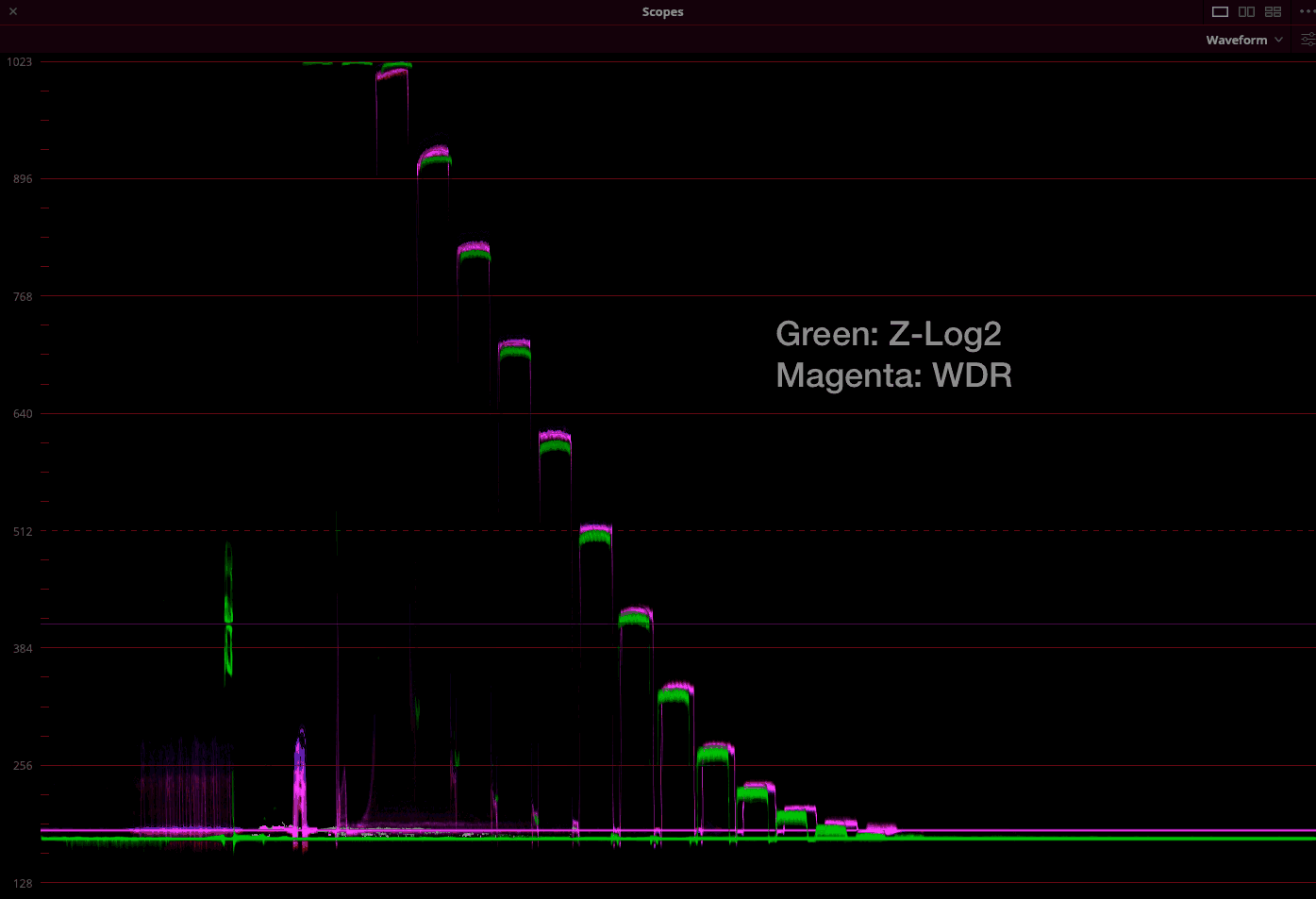
Several resolutions offer normal and “Low Noise” settings, and in some resolutions / frame rates an additional “low jello” setting is available. As you might expect, the low noise modes have less noise in the shadows, and the low jello modes have more noise:
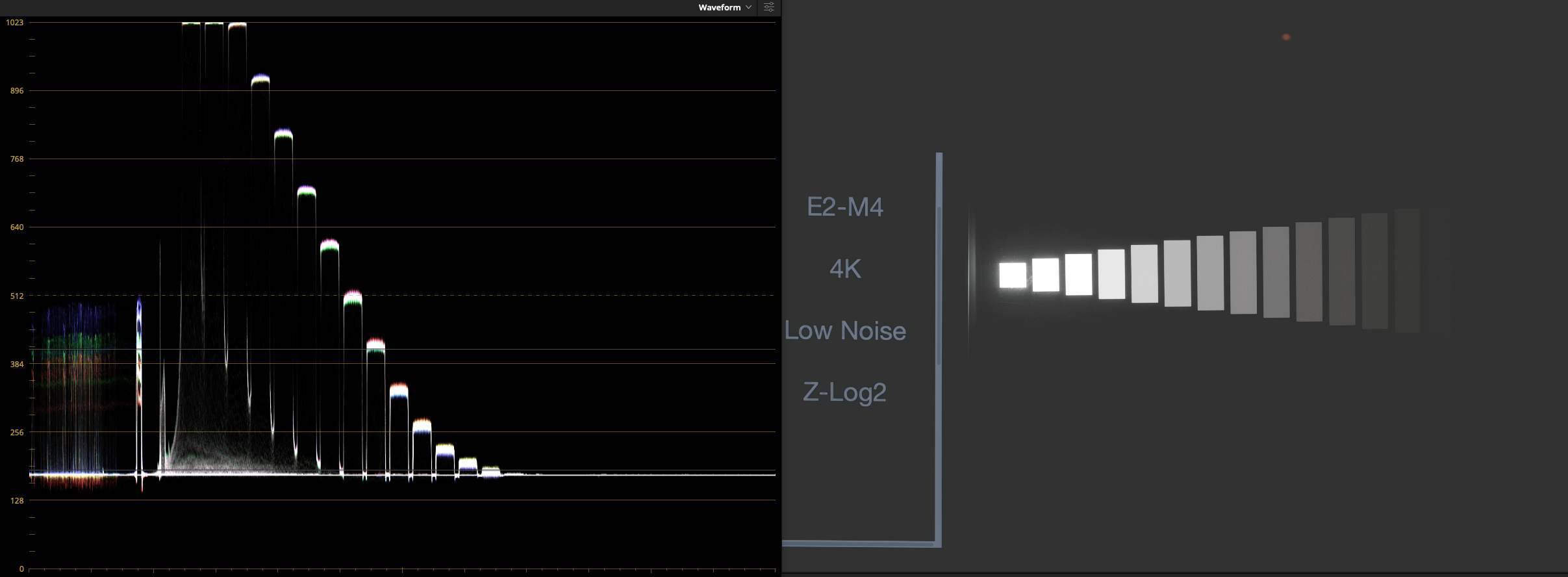
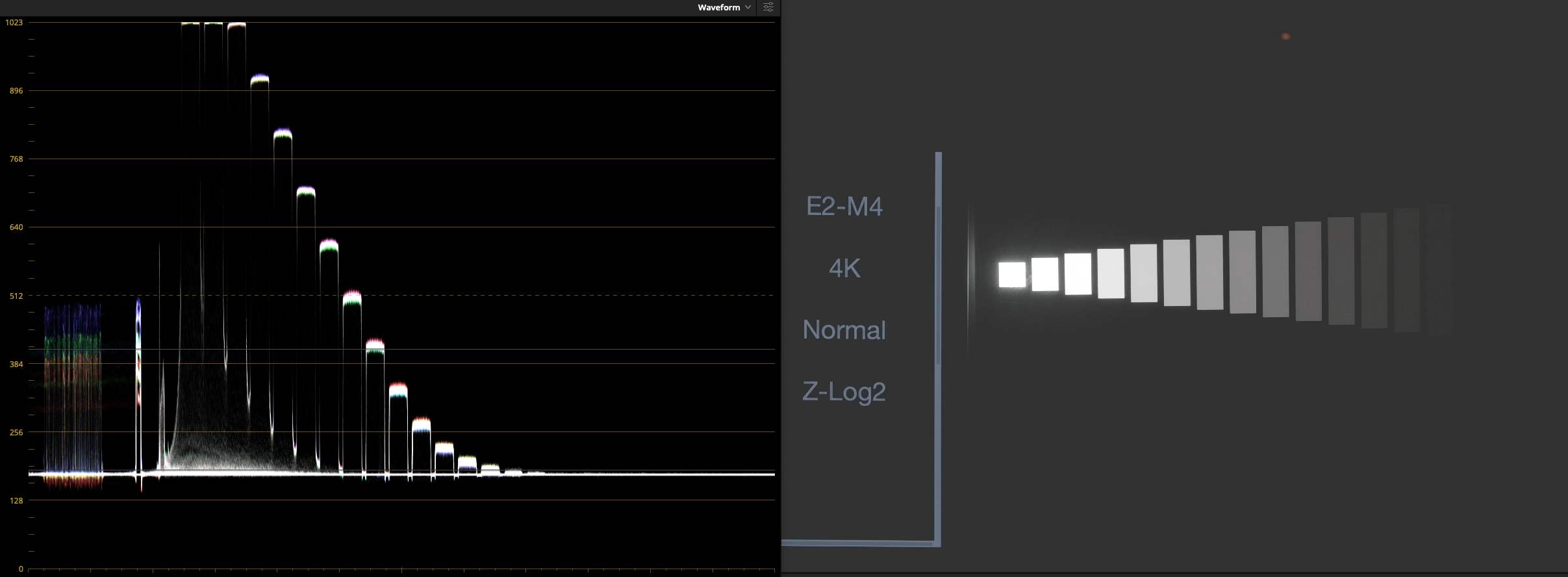
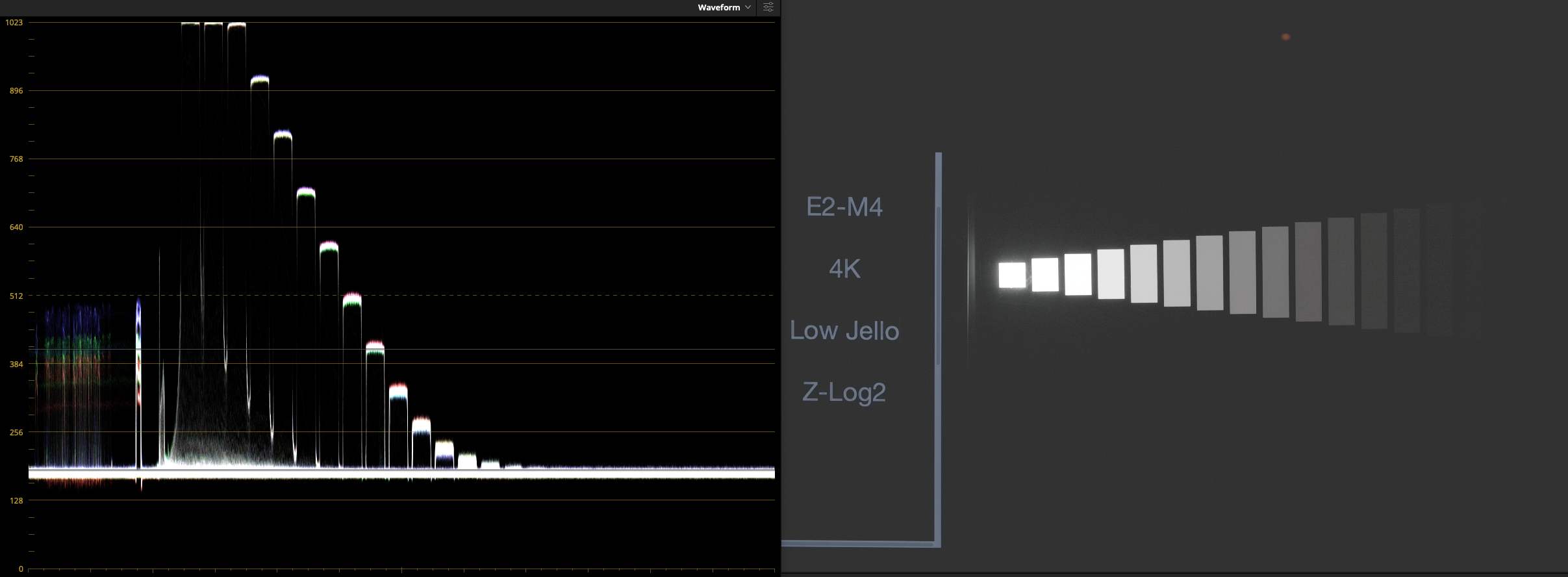
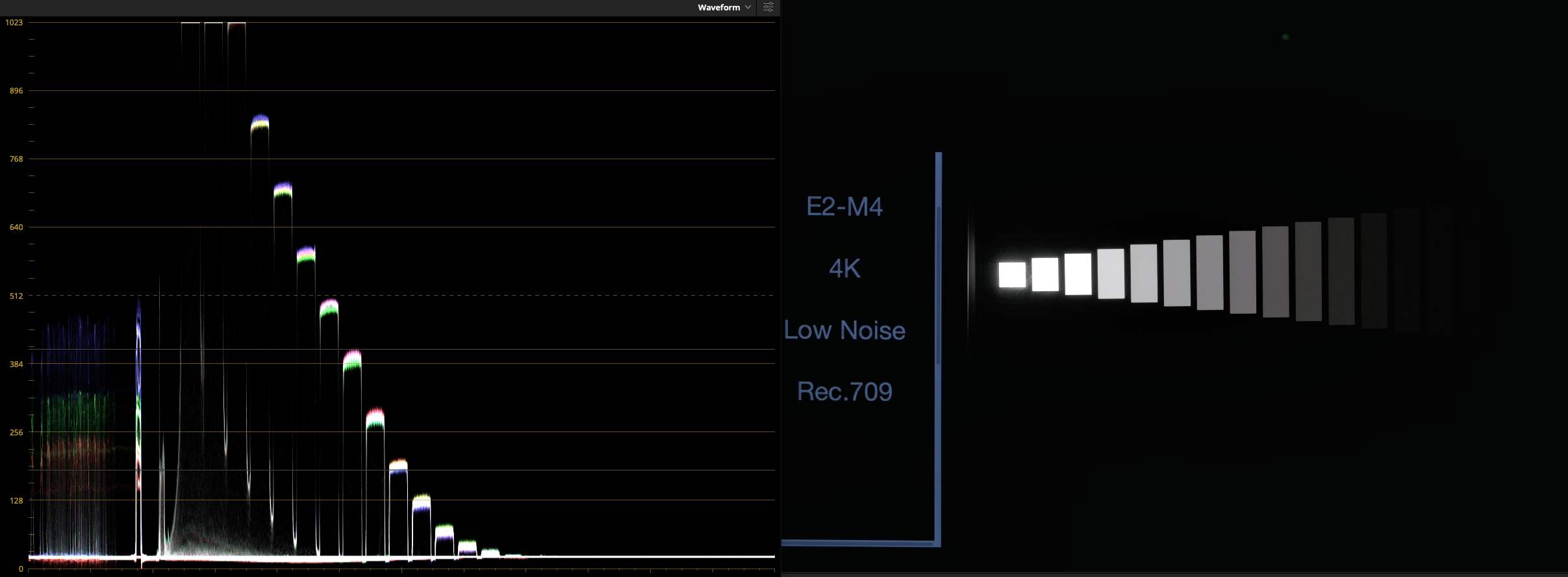
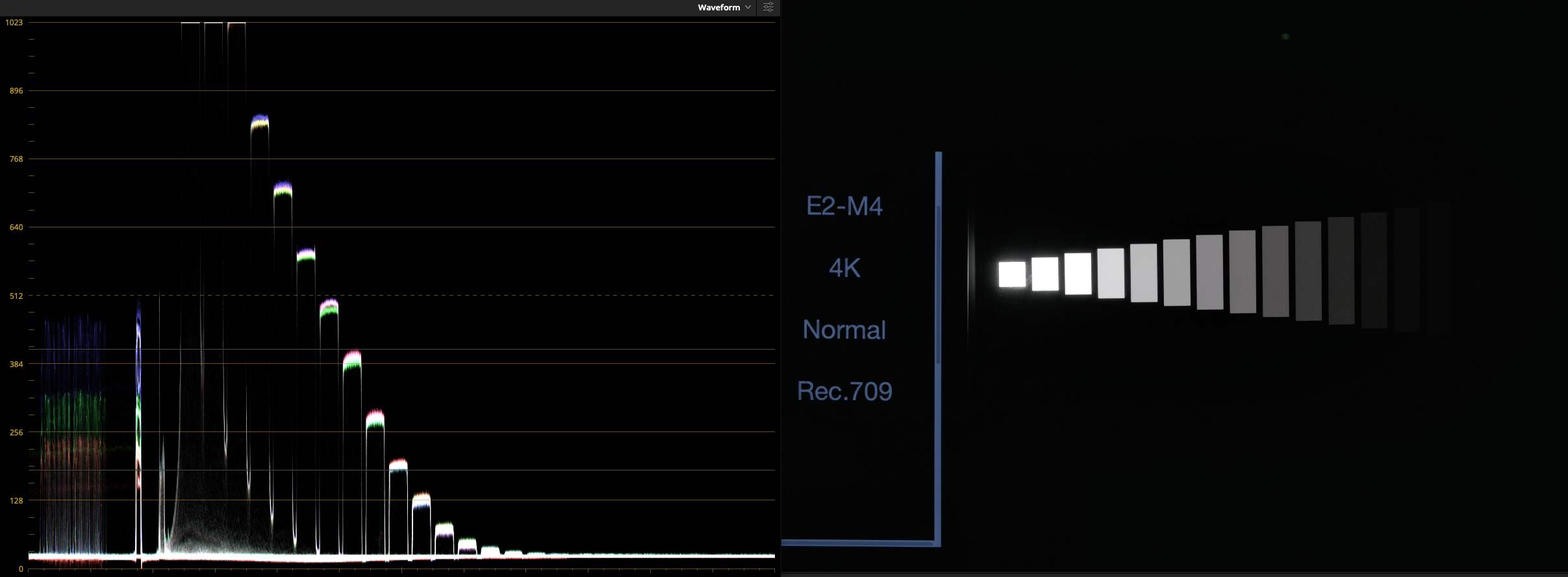
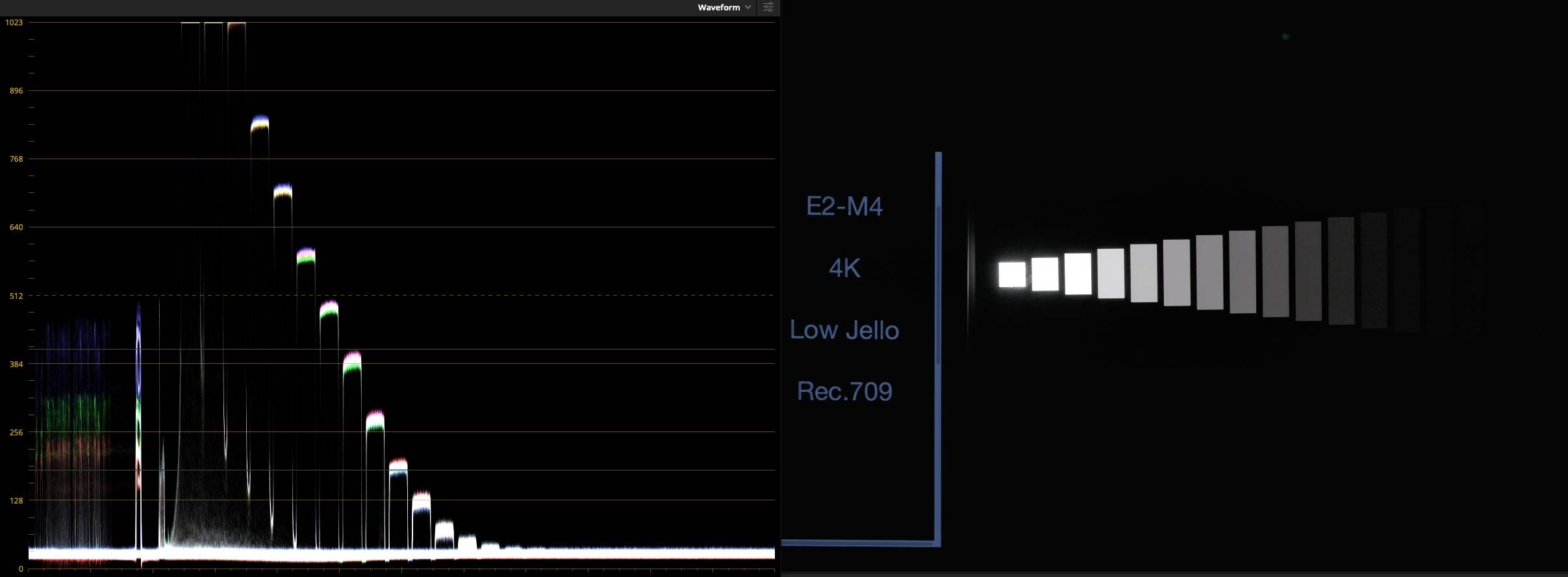
Another way of looking at DR is seeing how much over- or underexposure you can practically recover from. I shot a chip chart in Z-Log2 from 4.5 stops over to 4.5 stops under the nominal “correct” exposure, and graded them all to the same level in Resolve using two workflows:
– Using solely the offset control in an ACES workflow, using the zlog2_to-acesap0 Input DaVinci CTL to map Z-Log2 to ACES.
– Using the “exp stops” control in the ZLogColor OpenFX plugin for the main adjustment, fine-tuning with the plugin’s gain control, and setting the output’s output color space to Rec709.
Both workflows gave me effectively identical results, though the ACES clips showed more contrast than the ZLogColor-transformed clips. I exported from the non-ACES version because using a DCTL in ACES requires Resolve Studio for a non-watermarked-and-non-posterized output, and I only have Resolve Free, because I am a cheap bastard.
I shot exposure ramps using 4K normal, low noise, and low jello. All clipped non-specular highlights (the 90% reflective white patch on the chart) when overexposed by 4 stops. Where the noise level and black-level lift limit underexposure is a more subjective call, but roughly speaking low hello is a stop noisier in the shadows than normal, and low noise is maybe half a stop cleaner:
Rolling Shutter
The converse of the noise level is rolling shutter: cleaner images have more rolling shutter, noisier ones have less.
Normally, the rolling shutter time is a good measure of the maximum frame rate at a given resolution, but the “low jello” mode automatically kicks in to allow faster readouts when needed. For example, at 4K with low jello turned off, a 75 fps clip has the same rolling shutter as a 24 fps clip, but a 76 fps clip has the same jello as a “low jello” 24 fps clip, as does a 120 fps clip.
I measured rolling shutter by fast-panning a vertical line, then measuring skew within and between subsequent frames using an onscreen ruler. My readings are the average of four measurements from four different pans and are accurate to about +/-5%. For example the readings for 4K low jello, 4K 76fps, and 4K 120fps are essentially identical; the slight variations are more likely to be measurement errors than any actual difference. All measurements taken at 24 fps unless a different frame rate is listed.
| E2-M4 Resolution | Rolling Shutter, | Rolling Shutter, |
| milliseconds | fractional seconds | |
| 4K low noise | 29.8 | 1/34 |
| 4K | 11.3 | 1/88 |
| 4K low jello | 8.1 | 1/123 |
| 4K WDR | 16.4 | 1/61 |
| 4K, 75fps | 10.9 | 1/92 |
| 4K, 76fps | 8.1 | 1/124 |
| 4K, 120 fps | 8.2 | 1/122 |
| C4K | 11.4 | 1/88 |
| 4K 2.4:1 | 8.7 | 1/116 |
| 3696 x 2772 (1.33:1) | 14.5 | 1/69 |
| 3312 x 2760 (1.2:1) | 14.3 | 1/70 |
| S16 (2704 x 1600) | 8.5 | 1/118 |
| S16 16×9 (2112 x 1188) | 8.4 | 1/119 |
| 1920 x 1080 | 11.6 | 1/86 |
If you find jello excessively displeasing, Z Cam offers a 1” sensor global-shutter camera, the E2G, and an E2-S6G Super35mm flagship cam is under development.
ISO and Noise
The camera uses a dual native ISO sensor. I do see a slight drop in noise going from ISO 2000 to ISO 2500, but it’s minimal. I also see a very slight decrease in contrast once ISO 2500 is hit; that slight flattening is restored at ISO 12800. Make of that what you will.
I shot ISO ramps in Rec.709 and Z-Log2, both in 4K “normal” (not Low Noise, not Low Jello) with noise reduction off, and repeated the Z-Log2 test with NR set to Medium, its highest level. You’ll note more contrast in these clips that in the DR tests; I applied a timeline grade to make Z Cam’s Rec.709 look more like standard Rec.709.
(I should note that these clips were shot with AWB. With a fixed color balance, clips drift towards a magenta tint starting above ISO 10000.)
And I did a similar run with a GH5, because why the heck not?
(Note: you can compare the Z-Log2 and V-Log L pictures directly, ISO for ISO, but not the Rec.709 images; read on for details.)
I also shot a test at ISO 25600 at both extremes of Sharpness (Weak and Strong) and NR (Off and Medium):
The E2-M4’s sharpening is effective at subtly emphasizing fine detail without looking edgy, while the NR is gently cleansing without being intrusive.
The only downside of NR Medium (the highest level) is a slight change in color tracking across tones; middle-brights and middle-shadows drift a bit towards magenta. It’s noticeable on a grayscale chip chart; not so much in real life.
In a separate test, I looked for any evidence of “ghosting”, a faint residual image persisting a frame or two after its initial occurrence. Temporal noise reduction — processing multiple frames to reduce noise — can leave these ghosts or trails, but the Z Cam showed no evidence of such phantoms.
One of the Z Cam’s strong points is that the noise, reduced or not, remains fine-grained and color-free. When I tried to get comparable performance from my GH5, also equipped with a four-thirds sensor, pushing ISOs to the stratosphere results in a blotchy, chalky, plastic rendering with a lot more color noise. Indeed, all the mirrorless cameras I have handy give me a gritty, gravelly picture at high ISOs, the result of their comparatively heavy-handed processing.
It’s worth noting, though, that the Z Cam is set up so that clipping occurs at the same point in all profiles (WDR aside). If I set the camera to Rec.709, then open the iris until highlights start clipping, that aperture value will be the same if I run the same experiment using Z-Log2 or HLG. However, the midgray point will vary considerably between these profiles.
As a result, when I put the E2-M4 into Z-Log2 and the GH5 into V-Log L, and expose a gray card to 40%, I’ll get pretty much the same exposure reading on both cameras (and that reading agrees with my handheld meters). When I put both cameras into Rec.709, the GH5’s exposure remains the same, but I need to open the Z Cam’s lens about 2 to 2⅓ stops — or boost ISO by a comparable amount — to put midgray at 40% again. So, in essence, the E2-M4’s ISO value in Rec.709, normally exposed, is “wrong”; to match my meters I need to use a 4x or 5x higher ISO.
And yet, even with a nominal two-stop ISO penalty (if the GH5 is at 1600, the Z Cam image will be at 6400 or 8000), the E2-M4 yields a comparable or cleaner Rec.709 image when compared to the GH5. In log, where exposures match when ISO is the same, the Z Cam and the Panasonic are more evenly matched, but I still prefer the look of the Z Cam’s images.
Color and Tone
I find the E2-M4’s color rendering neutral, with no obvious distortions (mind you, I’m looking at test charts and natural scenes by eye; I’m not running analysis software on the images. Your visual mileage may vary). Skintones are clean with neither blotchiness nor suspiciously consistent hues.
I mentioned that the Rec.709 profile is low in contrast compared to “real” Rec.709. To match my other cameras, I had to boost that profile’s contrast from 50 to 67 and raise brightness from 50 to 60 to get a visual match. Even then, the Z Cam’s highlights tend to flatten a bit; above 60% or so there’s a gentle, S-curved compression. It’s similar in appearance to ARRI’s Rec.709 look or HLG’s log highlights, if not as pronounced as either of those.
The upshot of this lowered contrast is that even the Rec.709 profile captures 13 stops of dynamic range, just as Z-Log2 does, albeit with a different tonal mapping. It’s also, arguably, a more naturalistic rendering than standard Rec.709 now that we’re not stuck in the world of 5.5-stop CRT displays.
Likewise, I need to boost contrast in HLG from 50 to 67 to match the HLG curve on my GH5.
I find both the Rec.709 and HLG profiles to be perfectly usable as-is or with minor grading; their lower than normal contrast captures a wide tonal scale without crushing shadows or (with some care) nastily clipping highlights. As a result the images don’t say “video!” the way more contrasty, on-spec Rec.709 renderings can.
The E2-M4 shows a small amount of IR pollution: when I group a variety of black fabrics and hit them with a tungsten light, some of them veer a bit blue or magenta. It’s minor, nowhere near RED ONE territory (!); just something to be aware of.
VFR
Unusual at this price point is a range of decently high frame rates without significant image quality compromises. All the pixel-for-pixel formats (everything other than 1920×1080) maintain their full resolution from 1 fps up to the maximum that the format allows, with no added aliasing or other nasty sampling artifacts. If the frame rate exceeds that format’s normal rolling-shutter time, the camera drops into “low jello” mode, resulting in a small increase in noise — and that’s it. That 4K resolution chart earlier? It was shot at 120 fps.
You won’t always see this on an HDMI display, as the HDMI feed will degrade in quality at higher frame rates: the camera prioritizes recording quality and sacrifices HDMI quality when necessary. The recorded clips, however, look just fine.
The only exception is for 1920×1080 clips at rates above 120fps. Remember that 1920×1080 is normally “just” a downsampled 4K image, but 4K maxes out at 120 fps while 1920×1080 can romp all the way to 240 fps. To get those elevated rates, though, the sensor is scanned in a considerably less elegant manner:

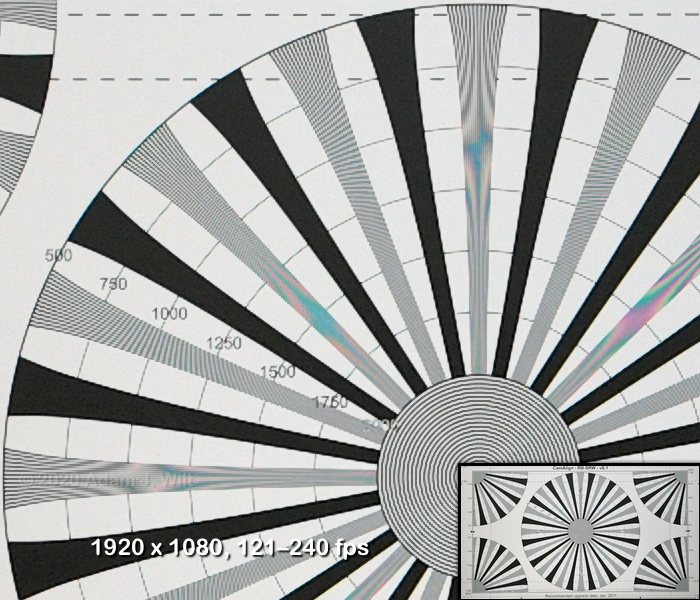
One pleasant feature for frequent off-speeders is that the Z Cam doesn’t have a special VFR or S&Q mode. Simply change Variable Frame Rate from “Off” to whatever rate you desire. You can even do this with one tap on the app’s main screen to bring up a scrolling list, no menu-diving needed. The camera gives you the option of “coarse” or “fine” control; coarse presents you with a list of 24 common frame rates (in 4K H.265), while fine gives you all 120 possible choices.
Audio
I don’t have one of those ARRI-style audio cables, so all my work has been with the 3.5mm input.
In Line mode the E2-M4 appears to be totally transparent: any signal I feed into the camera emerges from the edit with no audible difference from the original. In Mic mode there is perhaps a slight reduction in the richness of the sound; it seems at times to be a wee bit tinny (technical term; you can tell I’m not a soundie). I made this observation by feeding a variety of frequently-auditioned and well-memorized music tracks into the camera through my Sound Devices 302 mixer and comparing the recorded sound to the original. While I might not choose to record a full orchestra using the 3.5mm input at Mic levels, I’d have no qualms hooking up an on-camera mike for real-world audio recording; the loss of fullness was minor, and not noticeable except in A/B comparisons with the source.
Audio sync in normal recordings was fine. Z Cam says that assembling camera-split clips in an NLE instead of using VideoConcatenator can lead to sync errors, but I didn’t experience that.
I tried recording half-hour takes, both as single clips and as 1-minute-split clips which I then joined with VideoConcatenator, and neither the single nor the split clips showed any sync drift over time.
Audio sync in prerolled clips was a different story: most such clips had audio leading video by four frames (at 24fps), but in a few, audio led video by half a second. I saw the same errors with single or split clips, and with AAC or PCM audio.
When I assembled split clips in FCP X, I’d sometimes hear a level change when crossing subclip boundaries, and sometimes a pop or click. Stitching the subclips in VideoConcatenator eliminated level shifts, pops, and clicks.
I encountered one very odd thing. In trying to track down the level-shift issue, I recorded a bunch of clips using a white noise signal. Those clips played back fine in QuickTime Player, Screen, and Resolve, but in FCP X the track graphic renders with repeated fades, and the sound plays back as if all the water is draining out:
I occasionally heard a similar gurgling effect in voice and music in the middle of split-clip subclips when playing the subclips individually in FCP X; merging them with VideoConcatenator eliminated the effect.
This only occurs with AAC audio. When I record white noise using PCM audio, it plays back normally in FCP X and its rendered graphic matches what I hear.
Post Tools
Z Cam provides several apps for its cine cameras, free to download. These apps run on Mac or Windows.
ZRAW VideoSuite, for “developing” ZRAW files with basic grading tools, a WFM and histogram, and your choice of output profiles (Rec.709, Rec.2020, etc.). VideoSuite outputs 10-bit ProRes 422 .MOVs, 8-bit YUV422 RGB or 444 RGBA .MOVs, and 16-bit floating-point RGB .EXRs.
Z Cam StreamConverter, a basic camera remote controller with RTMP streaming capability.
Z Cam VideoConcatenator, for merging split files.
Z Cam VideoTranscoder, offering three distinct services:
- Recovering damaged files following power loss or other recording interruptions.
- Transcoding files to DNxHR HQX 10-bit 4:2:2 .MOVs.
- Copying embedded 720p H.265 proxy streams into standalone files.
These apps are perfectly functional, if unpolished. Input and output directories aren’t remembered between runs in Transcoder and Concatenator; VideoSuite opens full-screen and doesn’t resize gracefully; apps don’t have documentation of any sort other than a video tutorial for StreamConverter and one for VideoSuite, at least not that I’ve found.
Z Cam’s LUT page has:
- ZRAW plugins (Windows only) for Adobe Premiere and Assimilate Scratch allowing ZRAW files to be edited directly.
- Z CAM Color Correction Plugins for FCP X (Mac), Premiere (Mac/Windows) and an OpenFX plugin for DaVinci Resolve (Mac/Windows), providing comprehensive processing for Z-Log2 files. There’s a video demo of the Resolve plugin.
- LUT collections: at least 18 different LUTS in both 33- and 64-point .cube formats and both normal and cool-look variants, with seven different exposure levels from +3 stops to -3 stops.
An ACES Workflow page has OpenColorIO .spimtx files mapping Z-Log2 color to ACES AP0 and API; a Z-Log2 to linear .cube file, and DCTL files for using Z-Log2 in a Resolve Studio ACES project.
Documentation
As the camera’s firmware version of 0.96 might indicate, it’s a work in progress, and that goes for its documentation, too. There’s a Flagship series user manual, current (as I write this) with version 0.93, but it doesn’t include data for the E2-M4. There’s a manual for the E2 (non-flagship version), version 0.89; and an Appendix covering the frame rates for each resolution when using each codec for the E2 and E2-M4.
Z cam maintains additional documentation on GitHub, including general info and a full description of the different control protocols.
Beyond those and the video tutorials I listed earlier, nuggets of info drop on Z Cam’s Facebook group. Z Cam user Peter VanLoo has consolidated much of that info, along with Z Cam’s own docs, in the Z Cam Handbook; it’s worth a look.
Accessories
Most people wrap their Flagships in cages and support kit from Nitze, Smallrig, 8Sinn, Tilta, and others.
Multifunction handgrips from Portkeys and RVLVR give you more tactile controls if you’re not into the touchscreen lifestyle. Eric Naso has a good overview of the Portkeys offering.
Service & Support
Z Cams come with a one-year limited warranty. At present, repairs are handled by shipping your camera back to Z Cam via Hong Kong, with turnaround said to take only a few days, but other options are appearing.
In the USA, Ohio-based Solty’s Camera is “working closely with Z Cam to launch an official Z Cam service center (not yet officially launched but will be announced soon). This will cover out of warranty service and in warranty Z Cam service. We will offer full repair but of course special circumstances might [require the camera] to go to Hong Kong if we cannot process a unit. We have processed a few units with the soft launch already and have parts from Z Cam in house. Turnaround times range from 30 minutes to a day if parts are in house, and special circumstances might take 2-3 days. As for Hong Kong service the process is usually 1-3 business days with international priority shipping from Hong Kong, which arrives usually in 2-3 days. The process is very easy but the goal is to have all of North America Z Cam warranty be in North America.”
In the UK, CVP offers to manage the repair process; see https://cvp.com/services/professional_repairs for details.
And in the long term? I’m hesitant to bring this up, but there’s a chance that these cameras may not be long for this world. The E2 series appears to be built around HiSilicon controllers. HiSilicon is the chip-design subsidiary of Huawei, and both HiSilicon and Huawei are targeted by US trade sanctions, which make it increasingly difficult for HiSilicon to get their chips made. If Z Cam hasn’t secured their supply chain, or performed a lifetime buy (prepurchasing all the chips they expect to need for the life of a product line), the company could run through their stock on hand and be unable to obtain any more, effectively killing the product — and making electronic repairs to existing cameras problematic.
I have no information regarding the likelihood of this aside from what I read about HiSilicon in the business press. I bought an E2-M4 and I’m not losing sleep over it: it was only $1500, and if it works as long and as reliably as most such things do it’ll likely work for another decade or more.
Conclusion
The E2-M4 is a compact, capable, and affordable MFT cine camera. It combines a variety of high-resolution capture formats from 1.2:1 to 2.4:1 with internal raw and ProRes recording. It captures high frame rate clips without quality compromises up to 160 fps. It offers both log and “viewable” image profiles with 13 stops of dynamic range and robust, pleasing color.
The E2-M4 makes good pictures at very high ISOs, aided by restrained noise reduction that avoids an overly-processed look. It has unparalleled connectivity options for wired and wireless control and monitoring. It sips power sparingly. It captures its own raw format internally and works with a Ninja V monitor/recorder to capture ProRes RAW externally.
It has interchangeable lens mounts for MFT, EF, M, and PL lenses.
And it does all this for $1500.
As a box-style cine camera it calls out for cine-style support kit, and you can certainly fit it out that way. Yet it’s surprisingly usable as-is, with just an iPhone or iPad as its controller and monitor (in an emergency, you can even drive the camera with nothing more than its own buttons and 1.3” display).
Not everyone will gravitate to it; Brian Hallett isn’t a fan. It doesn’t have the switches and knobs of an ENG-style camera, and unless you’re using a multifunction grip and/or a separate audio mixer it likely won’t suit you for any sort of run ‘n’ gun work.
But if you can get your head ‘round the idea of driving a camera through a touchscreen, you may find you don’t need all the knobs and buttons, at least on more structured gigs. If you’re already used to working with cine-style cameras like Alexas or REDs, you’ll probably find the E2-M4 and its siblings perfectly familiar.
The camera and its software suite have a few rough edges: ZRAW recording with the wrong Luminance Levels clips highlights and shadows; the iOS app is schizophrenic in its orientation handling and doesn’t respect screen safe areas; Mac apps lack polish. Yet these deficiencies don’t prevent the camera from capturing high resolution, high frame rate images with wide dynamic range using high quality codecs at a very low cost.
Pros
- 4K capture, both DCI and UHD, up to 120 fps without visual compromises; 2.4:1 and S16 captures up to 160 fps, ditto
- Multiple aspect ratios and native anamorphic support
- 13 stops of dynamic range with neutral color rendering
- High ISO captures are surprisingly clean and usable
- ZRAW, ProRes, and 10-bit H.265 internal recording
- ProRes RAW external recording with an Atomos Ninja V
- Interchangeable lens mounts, including the world’s first positive-lock MFT mount
- Log, HLG, and Rec.709-like profiles
- Superb iOS control app with 1080p monitoring and minimal latency
- Comprehensive tools for raw and log processing
- Compact and lightweight body
- 5+ hours on a single NP-F970-style battery
- Only $1500
Cons
- ZRAW format is directly supported only in Windows Premier Pro and Scratch
- No Clear Scan / Synchro Scan shutter speed fine-tuning
- No timecode output or start/stop triggering over HDMI
Cautions
- AF uses contrast detection only
- Shooting ZRAW with Luminance Level set to Full results in clipped highlights and shadows; make sure Luminance Level is set to Limited before setting codec to ZRAW
- A programmable multifunction handgrip and/or an external audio mixer is required if you need to change audio levels and/or exposure parameters quickly and smoothly while rolling
- LUTs, focus-assist and exposure-assist tools applied to the HDMI output coarsen and blur the displayed image
- Exposures in non-log profiles won’t match external meters if the camera’s ISO rating is used
- Minor IR sensitivity
- Z Cam’s supply of essential components may be adversely affected by US sanctions
- “When using the product, maintain a distance of 20cm from the body to ensure compliance with RF exposure requirements.”
Disclosure: I purchased a Z Cam E2-M4 and an Angelbird CFast card / SSD combo pack at regular retail prices. Other than that there is no material relationship between me and Z Cam (or Angelbird, for the matter), and neither Z Cam nor anyone else has offered me any discounts, bribes, free trips to the Orkney Islands, or other compensation for this review.
I have worked for DSC Labs in the past. Some of my DSC charts were purchased, others were given to me, and the Xyla is on long-term loan.

Filmtools
Filmmakers go-to destination for pre-production, production & post production equipment!
Shop Now












